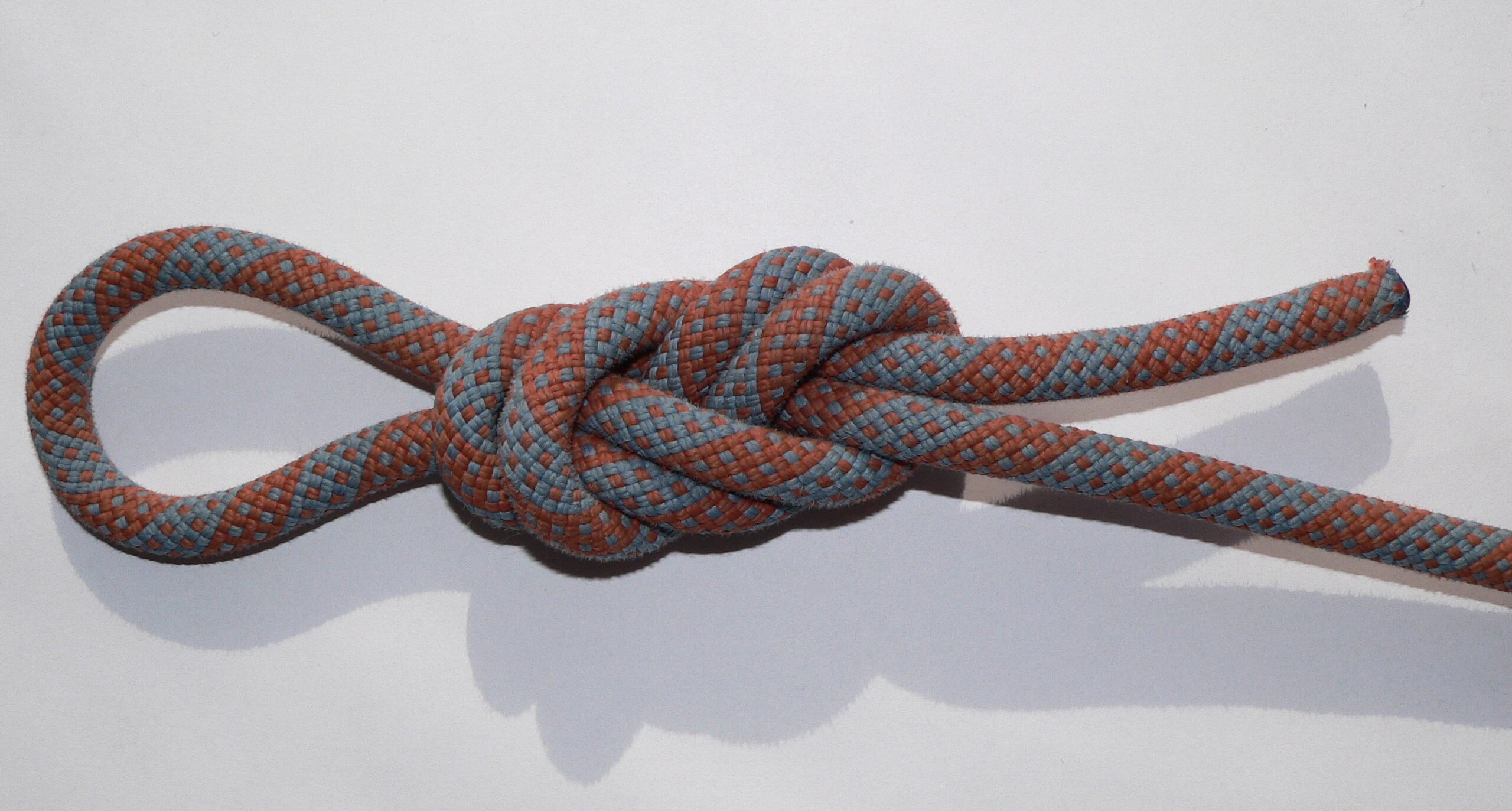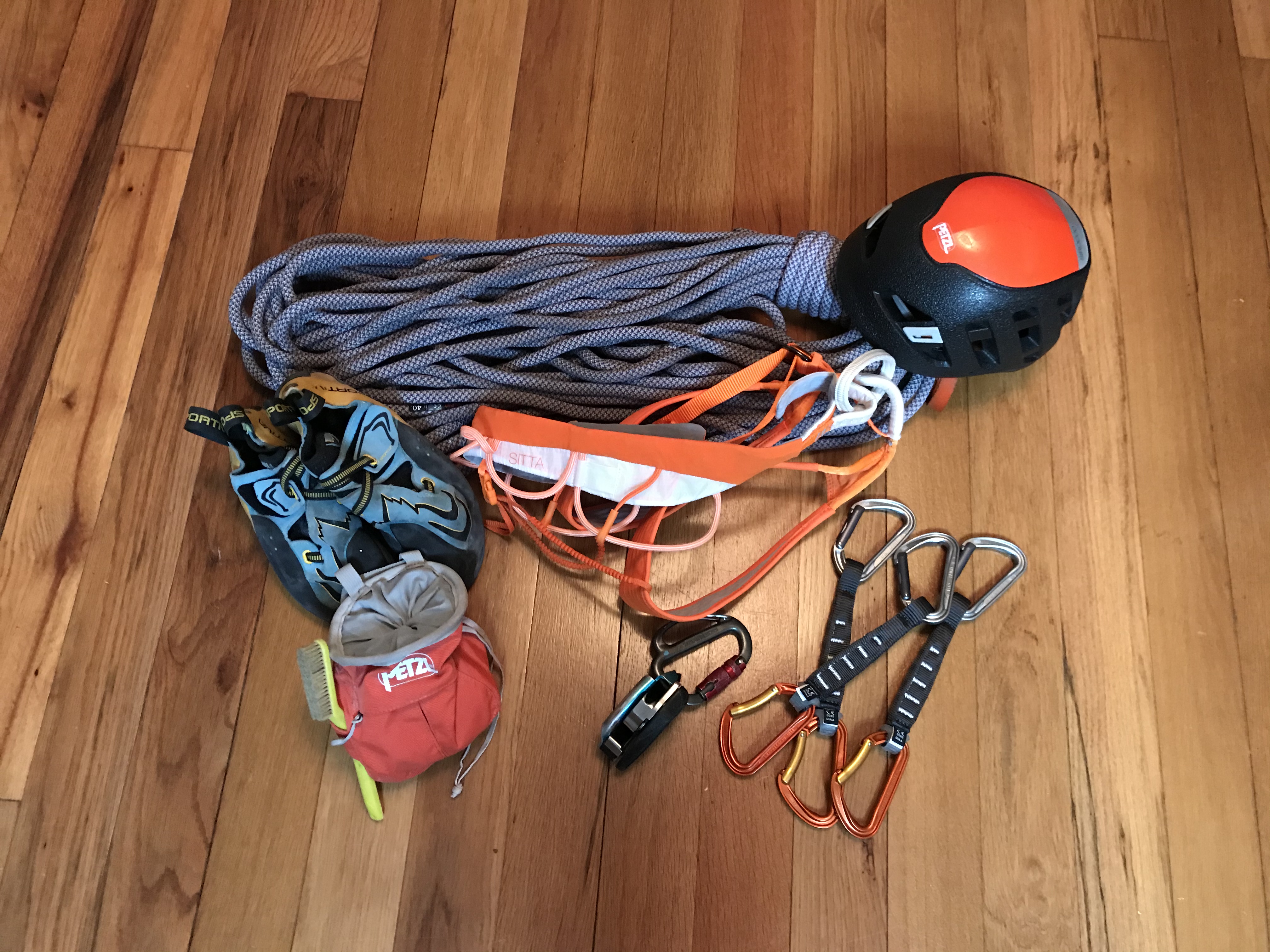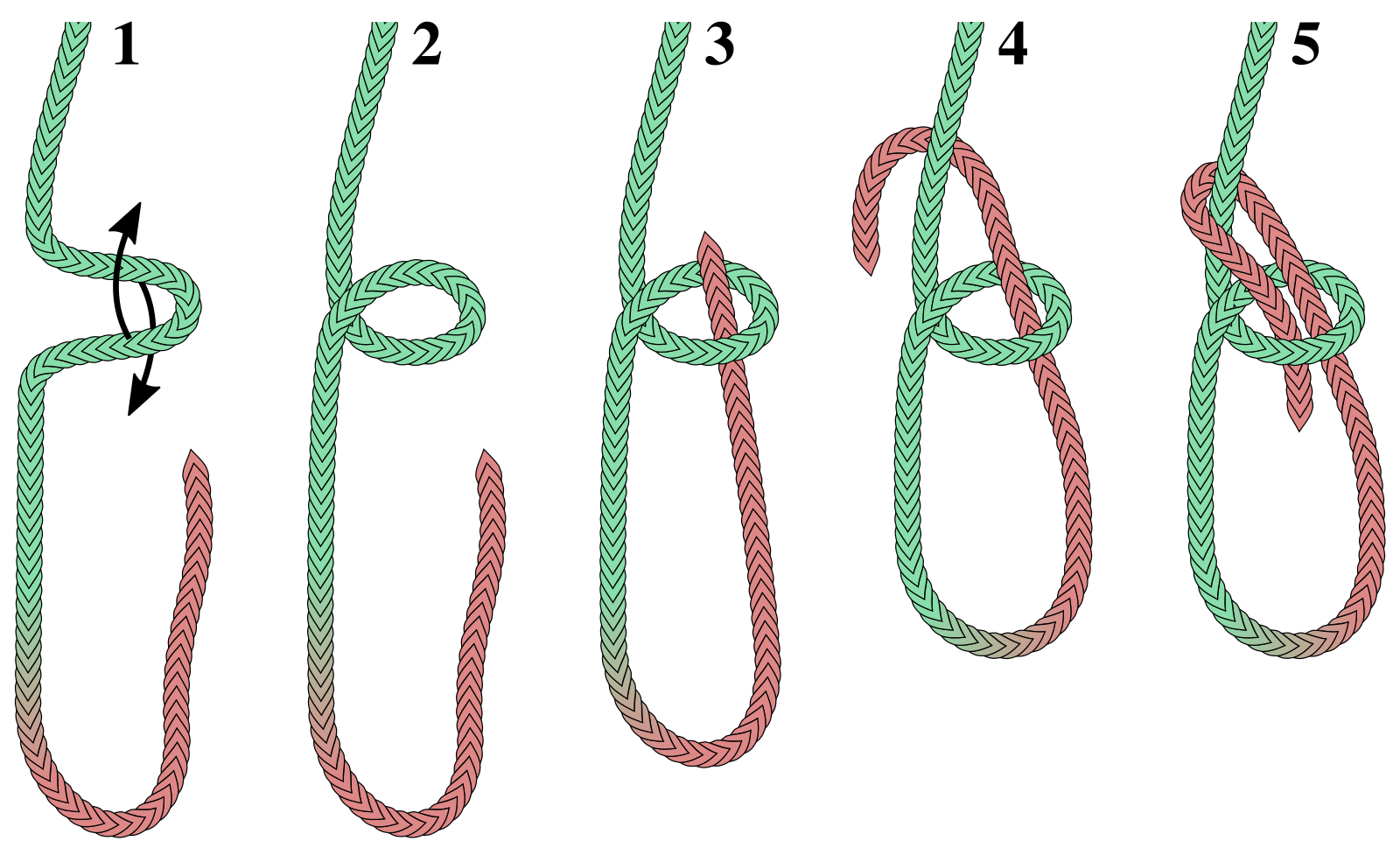|
Bowline On A Bight
The bowline on a bight is a knot which makes a pair of fixed-size loops in the middle of a rope. Its advantage is that it is reasonably easy to untie after being exposed to load. This knot can replace the figure-eight loop knot when tying into a climbing harness. It is one of the two tie-in knots that are being taught by the German Alpine Club (DAV), generally being considered secure. Dangers 2011 testing shows that the knot might slip when only one loop is loaded. Cavers and canyoneers ought to fasten their cow-tail carabiner through both loops. Video with genuine ''et voilà!'' ending European cavers widely advocate the use of a figure eight twisted version of the bowline on a bight. Applications This knot can be used to provide a toe hold in the middle of a rope; to make an emergency bosun's chair; and to create an upper rope "block" to make a crude purchase by threading the rope round an anchor point and then back up through the loop. It is sometimes used in sport climbi ... [...More Info...] [...Related Items...] OR: [Wikipedia] [Google] [Baidu] |
Double Bowline
A double bowline (or round turn bowline) is a type of loop knot. Instead of the single turn of the regular bowline, the double bowline uses a round turn. This forms a more secure loop than a standard bowline. Naming Though called "double bowline" by Clifford Ashley, this name is also reasonably descriptive of a different knot: the bowline on a bight The bowline on a bight is a knot which makes a pair of fixed-size loops in the middle of a rope. Its advantage is that it is reasonably easy to untie after being exposed to load. This knot can replace the figure-eight loop knot when tying into a .... Because of this ambiguity some sources differentiate by using one of the alternate names above. And at least one other source uses the name "double bowline" for a mid-line loop knot made by tying a basic bowline with a bight (knot), bight of rope instead of the end. Tying First, learn to tie the bowline by laying the working end on the standing part and twisting to form a loop (th ... [...More Info...] [...Related Items...] OR: [Wikipedia] [Google] [Baidu] |
Knot
A knot is an intentional complication in cordage which may be practical or decorative, or both. Practical knots are classified by function, including hitches, bends, loop knots, and splices: a ''hitch'' fastens a rope to another object; a ''bend'' fastens two ends of a rope to each another; a ''loop knot'' is any knot creating a loop; and ''splice'' denotes any multi-strand knot, including bends and loops. A knot may also refer, in the strictest sense, to a stopper or knob at the end of a rope to keep that end from slipping through a grommet or eye. Knots have excited interest since ancient times for their practical uses, as well as their topological intricacy, studied in the area of mathematics known as knot theory. History Knots and knotting have been used and studied throughout history. For example, Chinese knotting is a decorative handicraft art that began as a form of Chinese folk art in the Tang and Song Dynasty (960–1279 AD) in China, later popularized ... [...More Info...] [...Related Items...] OR: [Wikipedia] [Google] [Baidu] |
Figure-eight Loop
Figure-eight loop (also figure-eight on a bight, figure-eight follow-through, figure-eight retrace, Flemish loop, or Flemish eight) is a type of knot created by a loop on the bight. It is used in climbing and caving. The double figure eight is used to put a loop in the end of a rope, or around an object. It is relatively easy to tie and is secure, but can become difficult to untie after heavy loading, and can jam badly in any rope type. Tying methods On a bight A figure-eight loop is created by doubling the rope into a bight, then tying the standard figure-eight knot. In climbing, this knot is used to save time when repeatedly attaching the rope to climbing harnesses, using locking carabiners, such as when a group of people are climbing on the same top-rope. Follow-through Alternatively, to tie the knot directly around an object, the follow-through method must be used. * Tie a regular figure eight knot with a significant amount of extra tail. * Loop the tail around the o ... [...More Info...] [...Related Items...] OR: [Wikipedia] [Google] [Baidu] |
German Alpine Club
The German Alpine Club (german: links=no, Deutscher Alpenverein, DAV for short) is the world's largest climbing association and the eighth-largest sporting association in Germany. It is a member of the German Olympic Sports Confederation and the competent body for sport and competition climbing, hiking, mountaineering, hill walking, ice climbing, mountain expeditions, as well as ski mountaineering. It is an association made up of local branches known as 'sections'. History The German Alpine Club was founded as on 9 May 1869 in Munich by 36 former members of the Austrian Alpine Club around the Ötztal curate Franz Senn. It was founded in order to promote the development of tourism in the Eastern Alps through the building of mountain huts, and establishment of hiking trails, and via ferratas. The association had a large membership from the beginning, attracting 1,070 members in the first ten months. The German and the Austrian societies merged in 1873 to form the German an ... [...More Info...] [...Related Items...] OR: [Wikipedia] [Google] [Baidu] |
Karash Double Loop
Karash double loop is a common name for a knot forming two loops. This knot has been a known variant of the Bowline on a bight per the International Guild of Knot Tyers, referred to as ''bowline twist'' or ''twisted collar bowline on a bight''. The knot is also referred to as ''nœud de fusion'' in French references and sometimes called ''Fusion knot'' in English. The name ''Karash double loop'' was introduced by Mike Karash, who re-invented the knot to create makeshift harnesses for rescue operations and popularized it among rescue workers. Applications The knot is used for vertical caving using the single rope technique, particularly by French cavers. It is advertised by the French Federation of Speleology as a safe alternative to the ''bowline on a bight''. Compared to the traditional bunnyears variant of the figure of eight, its loops remain open under load allowing to clip and unclip carabiner A carabiner or karabiner () is a specialized type of shackle, a metal ... [...More Info...] [...Related Items...] OR: [Wikipedia] [Google] [Baidu] |
Sport Climbing
Sport climbing (or Bolted climbing) is a form of rock climbing that relies on permanent anchors (or bolts), permanently fixed into the rock for climber protection, in which a rope that is attached to the climber is clipped into the anchors to arrest a fall; it can also involve climbing short distances with a crash pad underneath as protection. This is in contrast to traditional climbing where climbers must place removable protection as they climb. Sport climbing usually involves lead climbing and toproping techniques, but free solo and deep-water solo (i.e. no protection) climbing on sport routes is also sometimes possible. Since sport climbing routes do not need to follow traditional climbing route lines where protection can be placed into natural features (e.g. cracks), they tend to follow more direct lines up crags. This aspect, in addition to the lack of any need to install protection during the climb (e.g. the sport climber just clips into pre-installed bolts along t ... [...More Info...] [...Related Items...] OR: [Wikipedia] [Google] [Baidu] |
Caving
Caving – also known as spelunking in the United States and Canada and potholing in the United Kingdom and Ireland – is the recreational pastime of exploring wild cave systems (as distinguished from show caves). In contrast, speleology is the scientific study of caves and the cave environment.Caving in New Zealand (from Te Ara: The Encyclopedia of New Zealand, Accessed 2012-11.) The challenges involved in caving vary according to the cave being visited; in addition to the total absence of light beyond the entrance, negotiating pitches, squeezes, [...More Info...] [...Related Items...] OR: [Wikipedia] [Google] [Baidu] |
Double Fisherman's Knot
The double fisherman's knot or grapevine knot is a bend. This knot and the triple fisherman's knot are the variations used most often in climbing, arboriculture, and search and rescue. The knot is formed by tying a double overhand knot, in its strangle knot form, with each end around the opposite line's standing part. Usage A primary use of this knot is to form high strength (round) slings of cord for connecting pieces of a climber's protection system. Other uses This knot, along with the basic fisherman's knot can be used to join the ends of a necklace cord. The two strangle knots are left separated, and in this way the length of the necklace can be adjusted without breaking or untying the strand. Tying Line form Image:Doppelter Spierenstich-1.jpg, Image:Doppelter Spierenstich-2.jpg, Image:Doppelter Spierenstich-3.jpg, Image:Doppelter Spierenstich-4.jpg, Drop form Image:Doppelter Spierenstich Tropfen-1.jpg, Image:Doppelter Spierenstich Tropfen-2.jpg, Image:Doppelt ... [...More Info...] [...Related Items...] OR: [Wikipedia] [Google] [Baidu] |
Bight (knot)
In knot tying, a bight is a curved section or slack part between the two ends of a rope, string, or yarn.. "Any slack part of a rope between the two ends, particularly when curved or looped." A knot that can be tied using only the bight of a rope, without access to the ends, is described as in the bight. The term "bight" is also used in a more specific way when describing Turk's head knots, indicating how many repetitions of braiding are made in the circuit of a given knot. Bight vs. open loop Sources differ on whether an open loop or U-shaped curve in a rope qualifies as a bight. treats bights and loops as distinct, stating that a curve "no narrower than a semicircle" is a bight, while an open loop is a curve "narrower than a bight but with separated ends". However, ''The Illustrated Encyclopedia of Knots'' (2002) states: "Any section of line that is bent into a U-shape is a bight." Slipped knot In order to make a slipped knot (also slipped loop and quick release knot), ... [...More Info...] [...Related Items...] OR: [Wikipedia] [Google] [Baidu] |
Bowline
The bowline ( or ) is an ancient and simple knot used to form a fixed loop at the end of a rope. It has the virtues of being both easy to tie and untie; most notably, it is easy to untie after being subjected to a load. The bowline is sometimes referred to as ''King of the knots'' because of its importance. Along with the sheet bend and the clove hitch, the bowline is often considered one of the most essential knots. The common bowline shares some structural similarity with the sheet bend. Virtually all end-to-end joining knots (i.e., bends) have a corresponding loop knot. Although the bowline is generally considered a reliable knot, its main deficiencies are a tendency to work loose when not under load (or under cyclic loading), to slip when pulled sideways, and the bight portion of the knot to capsize in certain circumstances. To address these shortcomings, a number of more secure variations of the bowline have been developed for use in safety-critical applications, or b ... [...More Info...] [...Related Items...] OR: [Wikipedia] [Google] [Baidu] |
List Of Knots
This list of knots includes many alternative names for common knots and lashings. Knot names have evolved over time, and there are many conflicting or confusing naming issues. The overhand knot, for example, is also known as the thumb knot. The figure-eight knot is also known as the Savoy knot or the Flemish knot. A * Adjustable Bend – can be easily lengthened or shortened * Adjustable Grip Hitch – a simple hitch which may easily be shifted up and down the rope while slack * Albright Special – used to tie two different diameters of line together, for instance to tie monofilament to braid *Alpine Butterfly (also known as Butterfly Loop) – a static loop mostly used by mountain climbers and rappellers for securing a carabiner to static rope. * Alternate Ring Hitching – covering a ring in hitching can prevent damage * Anchor Bend – attaching a rope to a ring or similar termination *Angler's Loop – knot which forms a fixed loop. Useful for fine or slippery line, it ... [...More Info...] [...Related Items...] OR: [Wikipedia] [Google] [Baidu] |





